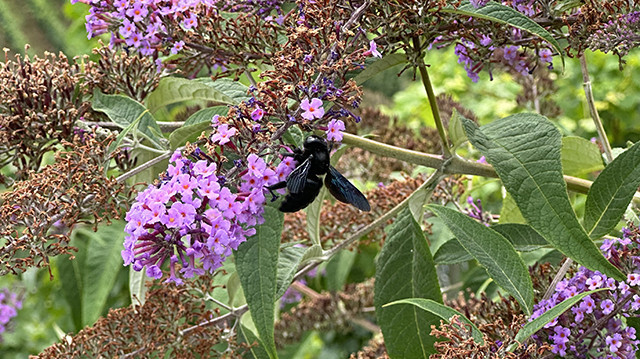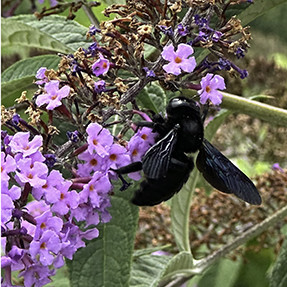(The feature photo, I have learned, is actually a Violet Carpenter Bee and not a Black Bumble Bee)
Ever ponder why black bumble bees are so vital to the environment?
They are pollinators and work as a key part in keeping ecosystems healthy.
In addition, they are necessary for our food supply.
Admire the special beauty of these intriguing creatures.
Plus, learn how you can assist in saving them.
What is a bumble bee?

The bumble bee is no ordinary insect! Boasting black and yellow stripes, these fuzzy flying creatures are easily recognizable.
They’re also vital pollinators in many ecosystems, aiding in the survival of numerous plant species. What’s more, they can buzz while in flight – their wings flapping up to 200 times per second!
But that’s not all. Unlike honeybees, bumble bees don’t produce large quantities of honey or have complex social structures.
Instead, they often live in smaller groups consisting of a queen and a few dozen workers. Plus, they have a special ability known as ‘buzz pollination’, which involves vibrating flowers at a specific frequency to release pollen.
Truly amazing, bumble bees show tremendous resilience in adapting to changing environments. According to a study by UC Berkeley’s Department of Environmental Science, they play an important role in maintaining biodiversity and ecosystem stability.
Black Bumblebee Species
Have you heard about the Black Bumblebee? It’s a captivating species that’s caught the attention of scientists and nature lovers. Let’s learn more!
Here’s a breakdown of this remarkable insect:
- Length: 20mm
- Color: Black
- Habitat: Woodlands and meadows
- Diet: Nectar and pollen
- Lifespan: 3-4 weeks
The Black Bumblebee is also well-known for its incredible navigational skills. It can move with great accuracy through complex structures like flowers. Here’s a true story that shows this bee’s amazing capabilities. In a garden, a single Black Bumblebee was collecting nectar from flowers despite harsh weather. It had tremendous resilience and determination to feed its colony.
California loves the Black Bumblebee because it looks cool even when wearing yellow and black!
Black Bumblebee California
The Black Bumblebee California is a rare and mysterious creature that fascinates scientists and nature enthusiasts. Its unique black color sets it apart from other bumblebees. With its scientific name being Bombus melanopygus, this species inhabits the coastal regions of California.
It has a solitary and non-aggressive behavior, making it stand out from other social bumblebee species. Its striking all-black appearance is what captivates people. It can be found in habitats ranging from coastal scrublands to meadows.
A dedicated researcher spent years observing and uncovering fascinating aspects of their behavior and ecological importance. The Black Bumblebee California continues to astound researchers and nature enthusiasts.
As we learn more about this remarkable creature, we unlock secrets that contribute to our knowledge of the intricate web of life on our planet.
Who needs therapy when you can just have black bumble bees around to remind you that life is full of unexpected stings and surprises?
The benefits of having bumble bees around
Bumble bees – those fuzzy, industrious creatures – play a critical role in our ecosystem. Their presence brings a range of advantages that benefit both plants and animals.
- They are ace pollinators for multiple plant species, guaranteeing cross-pollination to help reproduction.
- These resilient insects can fly at low temperatures. This means they are active earlier in the day and during colder months, when other pollinators are not.
- They use their wings to create a vibration at a special frequency. This helps disperse pollen from flowers more effectively.
- The nectar they collect from flowers is not only for nutrition – it’s also converted into honey. This gives bees and humans a treat!
- Bumble bees support biodiversity by aiding the growth of diverse plant populations through pollination.
- Their presence draws in other helpful insects to gardens and natural areas. This creates a balanced ecosystem by providing food for predators.
Plus, bumble bees help reduce soil erosion by helping plants stay rooted. They also increase seed production in flowering plants, which boosts the chances of their successful reproduction.
Pro Tip: You can encourage bumble bee populations by planting native flowering plants that provide plenty of nectar all year round.
But don’t forget – having bumble bees around can be dangerous, especially when they form their own biker gang called the Black Bumble Bees!
The dangers of having bumble bees around
Bumble bees can be harmless, but their stings can cause pain and allergies. Also, they may contaminate food sources near them and bring health risks.
These bees are known for pollinating plants. But their stingers contain venom that they use as defense.
Bumble bees are less aggressive than other bees, yet they may sting if they sense danger or if their hive is messed with.
Allergic reactions from their sting can be severe, like swelling and trouble breathing.
Moreover, they love sugary stuff, like human foods and drinks. So, they often come to picnics and outdoor gatherings where these are present.
This can be annoying and can put people at risk of accidental stings if they try to swat them away.
In addition, bumble bees may spread microbes while gathering nectar. These can land on fruits and vegetables that end up on our plates.
While most microbes are harmless, some can be hazardous. For instance, Escherichia coli bacteria has been found on their bodies. It is rare to cause illness, but it highlights the importance of washing produce before eating it.
How to tell if a bumble bee is friendly
Bumble bees are amazing creatures with their fuzzy bodies and gentle buzz. But how to know if they’re friendly? Here’s some tips:
- Observe behavior: Friendly bumble bees are calm and do their thing without stress.
- Look for body language: A bee with its tongue out or grooming is content.
- Listen for buzzing sounds: A low, steady buzz means it’s in a good mood.
- Note flight pattern: A straight flight path is a sign of friendliness.
- Check the environment: If collecting pollen from flowers, it’s likely a friendly bee.
Each bee is unique, so you can get to know them!
Pay attention to their cues to understand them better. Don’t miss this chance to appreciate them and observe their beauty.
They play an important role in pollination and biodiversity, so go interact respectfully and enjoy the wonder of nature!
When it comes to anger, if a bumble bee asks for your social security number, then you know it’s gotten serious.
How to tell if a bumble bee is angry
To tell if a bumble bee is angry, look for physical cues like it raising its abdomen and exposing its stinger. Or, listen for a high-pitched buzzing sound.
Defensive behavior like it quickly darting or bumping into objects also suggest aggression. Pay attention to facial expressions too – wide open mandibles or alert eyes might indicate anger.
Some bee species are more docile than others though.
If you see an angry bee, don’t make sudden moves or swat at it. Just calmly move away. And, if you get stung? Buzz right off to the nearest pharmacy for some sting-relief cream.
What to do if you are stung by a bumble bee
If you’ve been stung by a bumble bee, it’s important to know what to do. Here’s what to do:
- Assess the severity: Check how bad the sting is and if there’s severe pain, breathing difficulty or swelling in the face/throat, seek medical help.
- Remove the stinger: Scrape the area gently with a flat object like a credit card or fingernail. Don’t squeeze the stinger, as this can release more venom.
- Cleanse & soothe: Wash the sting area with mild soap & water. Put a cold compress or ice pack (wrapped in a clean cloth) on it to reduce pain & swelling. Take OTC pain relievers like ibuprofen or acetaminophen to help too.
Most stings aren’t serious unless you’re allergic. To prevent future stings:
- Wear protective clothing like long sleeves & pants.
- Avoid bright colors or floral patterns.
- Don’t disturb bees unnecessarily.
- Be careful with sugary foods & drinks outdoors.
- Consider carrying an epinephrine auto-injector if you’re allergic.
Bumble bee stings can be unpleasant, but if you act fast & use the right techniques, you can manage the situation & minimize any complications. Stay safe & informed!
How to get rid of bumble bees
Are bumble bees bugging you? Here’s a professional guide to help!
- Step 1: Identify the Problem.
- Search for signs of bumble bee activity, like swarming or nests.
- Make sure they’re actually bumble bees and not other similar-looking species.
- Step 2: Prevention.
- Block openings or cracks where bumble bees may enter.
- Clear potential nesting sites, like unused flower pots or old garden equipment.
- Step 3: Non-Lethal Removal.
- Contact a beekeeper to relocate the nest, if it’s not an immediate threat.
- Use natural repellents like peppermint oil or garlic spray to deter bumble bees from certain areas.
- Step 4: Professional Intervention.
- Consult a pest control specialist if the situation is unmanageable or dangerous.
Fun Fact: Black bumble bees (Bombus melanopygus) have been used for agricultural pollination! (Source: National Geographic) If you want bumble bees in your garden, just put out a sign that says ‘FREE HONEY POOL’ and watch the black bumble bee traffic soar!
How to attract bumble bees
Once upon a time, Sarah, an avid gardener, lived in a small countryside garden. She wanted to attract bumblebees so she followed these 3 simple steps.
- Plant a variety of colorful, pollen-rich flowers. Choose plants that bloom throughout the year.
- Provide shelter. Set up bee houses and tall grasses.
- Avoid pesticides. Use natural pest control methods.
To make the garden even more attractive, Sarah added water sources and fragrant flowers. Joyfully, she watched the bumblebees buzz around her garden. Her neighbors were inspired to do the same.
By creating an inviting environment, we can make bumblebees thrive alongside us. So, let’s embark on our own bumblebee adventure and enjoy their delightful buzz!
FAQ
Are black bumble bees dangerous or aggressive?
No, black bumble bees are generally not aggressive towards humans unless they feel threatened. They are more focused on pollinating flowers and collecting nectar, so it’s unlikely for them to sting unless provoked.
How do black bumble bees contribute to the environment?
Black bumble bees, like other bumble bee species, play a vital role in pollinating various plants, which helps promote the growth of fruits, vegetables, and flowers. They are important pollinators in ecosystems and contribute to maintaining biodiversity.
Are black bumble bees endangered?
Some black bumble bee species are indeed considered threatened or endangered due to habitat loss, pesticide use, and climate change. It is important to protect their habitats and provide safe environments for their survival.
How long do black bumble bees live?
The lifespan of black bumble bees varies depending on the species and environmental factors. Generally, bumble bees have a lifespan of a few weeks to several months. The queens can live up to a year in some cases.
Can black bumble bees sting?
Yes, like other bumble bees, black bumble bees are capable of stinging. However, they are not as aggressive as some other bee species. It’s important to give them their space and not provoke them to avoid getting stung.
How can I attract black bumble bees to my garden?
You can attract black bumble bees to your garden by planting native flowers that provide nectar and pollen. Creating suitable nesting sites and avoiding the use of pesticides can also help in attracting and supporting these important pollinators.




Leave a Reply